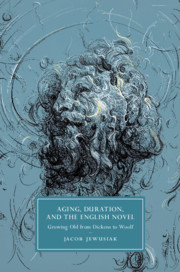Book contents
- Aging, Duration, and the English Novel
- Cambridge Studies in Nineteenth-Century
- Aging, Duration, and the English Novel
- Copyright page
- Dedication
- Contents
- Acknowledgments
- Abbreviations
- Introduction
- Chapter 1 Aging Theory
- Chapter 2 No Plots for Old Men
- Chapter 3 Life After the Marriage Plot
- Chapter 4 A Wrinkle in Time
- Chapter 5 The Technology Age
- Chapter 6 Gray Modernism
- Afterword
- Notes
- Bibliography
- Index
- Cambridge Studies in Nineteenth-Century
Chapter 3 - Life After the Marriage Plot
Published online by Cambridge University Press: 14 November 2019
- Aging, Duration, and the English Novel
- Cambridge Studies in Nineteenth-Century
- Aging, Duration, and the English Novel
- Copyright page
- Dedication
- Contents
- Acknowledgments
- Abbreviations
- Introduction
- Chapter 1 Aging Theory
- Chapter 2 No Plots for Old Men
- Chapter 3 Life After the Marriage Plot
- Chapter 4 A Wrinkle in Time
- Chapter 5 The Technology Age
- Chapter 6 Gray Modernism
- Afterword
- Notes
- Bibliography
- Index
- Cambridge Studies in Nineteenth-Century
Summary
The third chapter, “Life After the Marriage Plot,” examines how the women of Elizabeth Gaskell’s Cranford preserve a temporal zone from the dual threat of patriarchy and modernization. The late-life romance between Miss Matty and Mr. Holbrook—a marriage plot without the possibility of marriage—generates narrative interest because it follows a set of temporal rules that originate from within Cranford rather than conforming to conventions about age and romantic love from outside the community. The superannuation of persons relates to a similar crisis in the marriage plot, which no longer reflects the experience of the older characters it purports to organize. Thus, I read Cranford’s representation of other forms of media—such as storytelling, the newspaper, and the letter—as a reflection on the formal obsolescence that takes place within the larger narrative economy of the novel. What emerges is a reconceptualization of the utility of what is “old,” insofar as the women of Cranford reterritorialize the obsolete as a particularly feminine challenge to the temporality of modernity.
- Type
- Chapter
- Information
- Aging, Duration, and the English NovelGrowing Old from Dickens to Woolf, pp. 70 - 89Publisher: Cambridge University PressPrint publication year: 2019

